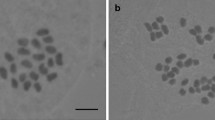Abstract
Morphological, cytological and ecological observations were made onLycopodium clavatum. Among 121 individuals from 26 populations studied 31 were of the diploid cytotype with 2n=68, 45 were of the triploid cytotype with 2n=102 and 45 were of the tetraploid cytotype with 2n=136. The populations were divided into three types: (1) the sole type—characterized by a single cytotype occupying an entire population, (2) the mixed type A—characterized by two or three cytotypes occupying together the same population, but each cytotype choosing different habitats, (3) the mixed type B—characterized by two or three cytotypes occupying together the same population and sharing the same habitat with each other. The mixed type B populations were found in the places of the early phase of secondary succession in a plant community. In the sole type and the mixed type A, the habitat preference for each cytotype was described as follows: the habitat for the diploid was in humid and shady places, that for the tetraploid was in open and sunny, unstable places, and that for the triploid was intermediate between the other two. Each cytotype can progress towards occupying their optimum habitat successively from the mixed type B population to the mixed type A population and finally reaching the sole type population.
Similar content being viewed by others
References
Baker, J.G. 1887. Handbook of the Fern-Allies. George Bell & Sons, London.
Ghataka, J. 1965. Some evidences of cytological evolution inLycopodium L.s.l.. Nucleus8: 45–58.
Löve, Á andD. Löve. 1958. Cytotaxonomy and classification of lycopods. Nucleus1: 1–10.
—and—. 1966. Cytotaxonomy of the alpine vascular plants of Mount Washington. Univ. Colo. Studies, Ser. Biol.24: 1–74.
—and—. 1976. IOPB chromosome number reports LIII. Taxon25: 484–487.
andR.E.G. Pichi Sermolli. 1977. Cytotaxonomical Atlas of the Pteridophyta. Cramer, Vadus.
Lovis, J.D. 1977. Evolutionary patterns and processes in ferns.In: R.D. Preston and H.W. Woolhouse, ed., Advances in Botanical Research4: 229–415. Academic Press, London.
Manton, I. 1950. Problems of Cytology and Evolution in the Pteridophyta. Cambridge Univ. Press, Cambridge.
Mehra, P.N. andS.C. Verma. 1957. Cytology ofLycopodium Curr. Sci.26: 55–56.
Mitui, K. 1968. Chromosome and speciation in ferns. Sci. Rep. Tokyo Kyoiku Daigaku Sec. B13: 285–333.
Nakai, T. 1925. Notes on Japanese ferns II Bot. Mag. Tokyo39: 176–203.
Nessel, H. 1939. Die Bärlappegewächse. Gustav Fischer, Jena.
Ohwi, J. 1965. Flora of Japan, Engl. ed. Smithsonian Inst., Washington.
Sorsa, V. 1958. Chromosome studies on Finnish Pteridophyta I. Hereditas44: 541–546.
— 1961. Chromosome studies on Finnish Pteridophyta II. Hereditas47: 480–488.
— 1962. Chromosomenzahlen Finnischer Kormophyten I. Ann. Acad. Sci. Fenn. A. IV Biol.58: 1–14.
— 1963a. Chromosome studies on Finnish Pteridophyta III. Hereditas49: 337–344.
— 1963b. Chromosomenzahlen Finnischer Kormophyten II. Ann. Acad. Sci. Fenn. A. IV Biol.68: 1–14.
Spring, A. 1842. Monographie de la famille des Lycopodiacées. Nov. Mem. Acad. Roy. Sci. Bel. Letter. Brux.15: 1–110.
Tagawa, M. 1959. Coloured Illustrations of the Japanese Pteridophyta. Hoikusha, Osaka (in Japanese).
Takei, M. 1974. A new cytotaxonomic strain ofLepisorus thunbergianus. J. Jap. Bot.49: 356–359 (in Japanese).
— 1978. On the polyploids ofLepisorus thunbergianus (2). Three cytotaxonomic strains in Oita Pref. J. Jap. Bot.53: 87–91 (in Japanese).
Tanaka, R. andM. Takamiya. 1981. Polyploidy inLycopodium clavatum of Japan. Chromosome Information Service31: 5–6.
Walker, T.G. 1966. A cytotaxonomic survey of the pteridophytes of Jamaica. Trans. Roy. Soc. Edinb.66: 169–237.
Wilce, J.H. 1972. Lycopod spores, I. General spore patterns and the generic segregates ofLycopodium. Amer. Fern J.62: 65–79.
Author information
Authors and Affiliations
Rights and permissions
About this article
Cite this article
Takamiya, M., Tanaka, R. Polyploid cytotypes and their habitat preferences inLycopodium clavatum . Bot Mag Tokyo 95, 419–434 (1982). https://doi.org/10.1007/BF02489478
Received:
Issue Date:
DOI: https://doi.org/10.1007/BF02489478




